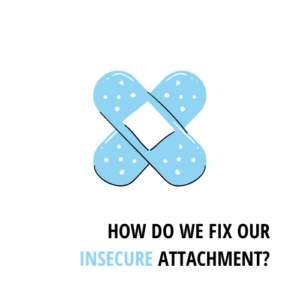Just a quick recap of Attachment Styles before we dive into how to ‘fix’ our Insecure Attachment.
Our Attachment is our ability to receive love and to give love. It is our self-belief that we are worthy of love, that we can trust others with our vulnerability, and whether we feel like we could survive potential abandonment. It is big stuff, in fact Attachment is really the foundation to our psychology.
So, a quick reminder, roughly half the population are Securely Attached and roughly half are Insecurely Attachment. Insecure Attachment is broken down into two subgroups – Anxious Insecure and Avoidance Insecure. You can read more on ‘What is Attachment in Psychology’ and ‘What is your Attachment Style’.

‘Yeah, but how do I fix my insecure attachment?’
Helping people recover from their insecure attachment is a common theme in therapy. We work through the client’s insecurities in session, and hopefully life gives us opportunities for healing also. These are called ‘corrective experiences’ – when a reliable, well intended person comes into our lives and we learn that we are worthy of their love and they are not going to abandon us.
Let’s break it down… With Insecure Attachment, fear has blocked us from having the relationships that we truly want to have. We can feel panic whenever there is conflict or distance in our romantic lives. We automatically brace ourselves, believing that we are about to be abandoned or abused. While being in love fills us with anxiety, being without love is unbearable.
We may notice that these patterns continue to resonate throughout our lives. When we experience insecure attachment, unless we learn about our fears and our patterns and recalibrate our early sense of belonging, we will continue to repeat the same behaviour over and over again. We will continue to feel confused and helpless. We won’t understand ourselves. This is about stepping out of Groundhog Day and learning to be loved.
Our attachment style shapes us in how we are with our loved ones from the cradle to the grave. But our way of thinking about ourselves and our relationships is not rigid; it continues to be shaped and influenced by positive and negative experiences throughout our life. Our degree of feeling secure or insecure moves around depending on our life experiences. We might start out secure and then have rough teen years with our peers, causing us to become insecure. We might travel well and securely through our child and teen years and then have a critical and oppressive partner who drags us backwards into a state of insecurity.
It’s important to know that having insecure attachment as a child does not doom us in our adult relationships. Even if we experience insecure attachment as a child, we can shift this attachment style in adulthood. The good news is that we can recover and claw our way back to a state of security by getting our head healthy, and by having positive relationships that give us a ‘corrective experience’ through which we can relearn. The indepth skills required are covered in ‘Understanding Myself – SIGNPOSTS FOR LIVING; Book 2.
The family home is the most powerful structure of human belonging in the world. It is the place where growth, launching, and consolidation occurs. Unfortunately, it is also the place where the most wounds can be inflicted. Wounds that can take a lifetime to heal. The most difficult type of attachment trauma to recover from is the insecure attachment that stems from childhood. This is because our childhood is formative. Children are more able to feel secure, loved and connected if their parents are attuned to the child’s internal world of emotional needs. When the parent is attuned to the child, the child feels heard and understood, and this helps the child learn to calm themselves. They also become more skilled and able to connect and engage in empathic, meaningful relationships later in life.
To love and to be loved
There are so many ways in which parents may fail to meet their child’s emotional needs. So many ways we can stuff it up! Parents may be emotionally unavailable because they are preoccupied with their own lives, or they may be struggling psychologically. This may cause the child to adapt by dismissing the importance of their own needs, their emotions and their relationships. The child may therefore try not to be dependent on others and may build up a wall as a coping mechanism, believing that they don’t need to rely on others.
Or if the parent/s have been inconsistent in their emotional availability and attunement, the child may end up feeling confused and suspicious about how reliable their parents are. The child may grow to develop worries about whether their partner reciprocates their feelings.
Being apprehensive about whether others will be reliable and responsive to us may make us reluctant to let others in and to get close with them emotionally and intimately.
If a parent was abusive and frightening, their child’s formative years may have been riddled with fear. The child will feel a need to hide, but also want the parent to be there for them and soothe them. This may cause them to grow up into adults who are confused about relationships and their emotions. They may have learned to be the soother – the one who looks after the needs of the person causing distress – at the expense of their own needs and emotional state.
Unconditional acceptance is extraordinarily important to children. As a child, if our parents threaten to withdraw their love from us when we fail to measure up, then our natural playfulness is gradually replaced by chronic anxiety. Children need to feel that their parents are unconditionally committed to their welfare. This allows them to relax and explore the world without fear. When children feel this way, they don’t need to allocate psychological energy to their own protection. Being able to identify the patterns in our history and how they have shaped us puts us on solid footing to move forward and recover from any unhelpful attachment behaviours.
It is difficult to love ourselves if we are not first loved. Our parents and our social environment give us the language to form our understanding of the world. We primarily see the world through this language from our parents. As part of the process of developing, the child asks, ‘Who am I?’ and, ‘How do I feel about myself?’ The child starts off largely as a blank canvas and, unfortunately, might have a negative assumption to begin with. (‘Maybe I am not okay, not good enough.’) The parent’s job is to see their child, to hold up a mirror and to reflect back to the child how precious they are, and how their uniqueness and their capability is celebrated.
This external language then becomes internal language for the child over time. It becomes the child’s self-talk. This self-talk then becomes the lens for how they see themselves, others and the world, as they launch into the rest of their lives. This is why childhood is so critical to adult development. It is because of this crucial gentle forming of our view of ourselves and the world that we need to be vigilant in protecting children from the uncertainties and the horrors of the world – the adult world.
Our goal is to work towards becoming securely attached, and to develop positive self-talk. To let ourselves understand that we are lovable because we actually have self-love. Secure people strive to find a good balance between dependence and independence. The goal is to know that if we are hurt, we feel solid in ourselves – we know we will recover if the worst does happen. We can learn that it’s healthy to admit when we are upset, and we can try to use our distress to achieve constructive outcomes in our relationships.
The goal is to be grounded enough to take time getting to know our partner and friends, interviewing them, knowing them on a bad day when under stress, being an expert on their ugly side. Only then can we feel confident that we are making an informed decision that this person is trustworthy and adds value to our lives. We then can feel confident that they deserve us. The healing approach is to cultivate a sense of compassion for ourself and understand where our fears have come from. Through understanding or self talk and understanding our emotions, we can allow the fears to come and go, and experience the freedom to let love in if we choose to do so.
Quality psychological therapy focuses on clients’ attachment style. Attachment issues are at the root of most interpersonal problems. Some types of therapy, such as Emotion Focused Therapy, work predominantly with the individual’s attachment needs. One person might fear criticism from their partner, thinking, My partner will think I’m not good enough and they might leave me. The other partner might worry, My partner is going to cheat on me because I have been cheated on before.
We develop deeply ingrained habitual ways of interacting with others. We need to work out what these habitual patterns are if we are going to heal and move forward. We need to understand how the person who we are today has been influenced by previous relationships, our early childhood experiences or our other significant adult relationships. We need to respect how our history of connection or disconnection with others has shaped our ability to love and feel loved. This of course links to ‘Knowing your hot issues.’
Let’s make the point here again: humans have a terrible tendency to repeat old habitual and disastrous patterns. We routinely fear change even when it is clearly good for us. Another sad fact is that many dysfunctional relationships and patterns in life continue because our fear of the unknown is greater than our fear of the unhealthy patterns in our life. So we sit still. We do nothing. We continue to bang our heads on the wall and complain that it hurts. Our challenge is to seek to understand what sets off our reactions, and to expand our awareness and capacity to respond in a healthy, thriving way.
Unless we step back and heal our attachment style, we will repeat our relationship patterns over and over again with different people. We will feel perplexed and helpless about the relentless repetition happening in our lives. But through greater awareness of old patterns that do not serve our health or well-being any longer, we begin to experience a freedom to grow in our capacity, to see new possibilities and to discover new pathways in relating to and loving ourselves and our loved ones. This is about getting unstuck and moving, growing and healing. This all comes from awareness of and then freedom from old patterns. Do we need therapy to achieve this? Perhaps not; we can work through issues ourselves if we have the skills of introspection, and if we have supportive others to discuss our insights and progress with. Does therapy help? Most likely; it can fast track us and it can assist us if we don’t quite have the skills or supports to go solo.
Wish you well, take care.



Subscribe To Our Newsletter
Join our mailing list to receive Psych wisdom, advice and encouragement once a month.
"The Skills we need are not just common sense, we need to learn them from somewhere"
You have Successfully Subscribed!